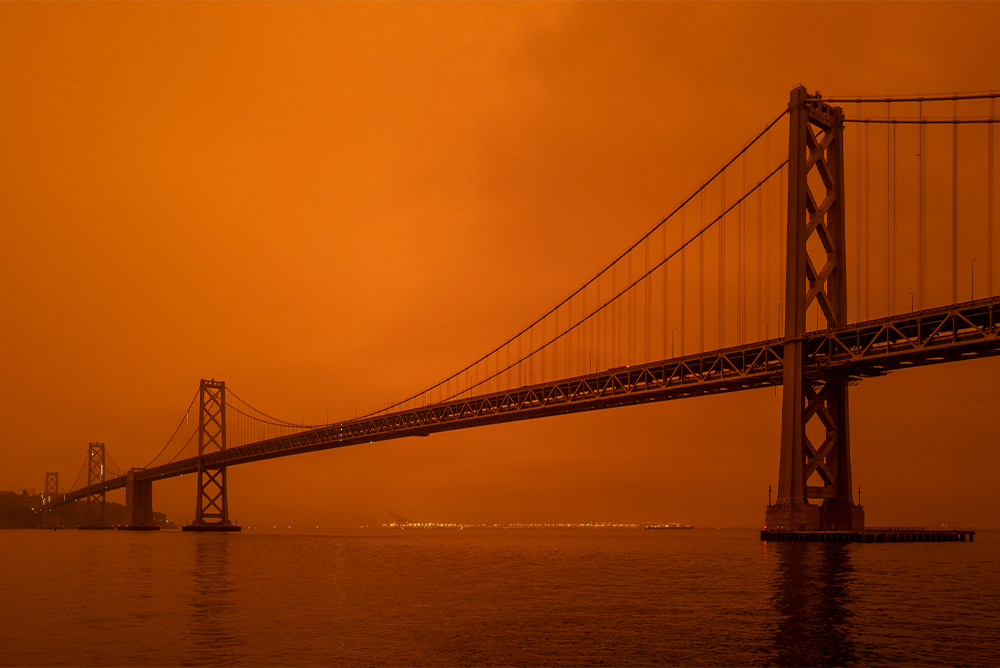
Welcome to California, where beauty and danger live side by side, writes columnist Joe Mathews. Courtesy of Christopher Michel/Flickr (CC BY-NC-ND 2.0).
Early in the film Chinatown, a Southern California coroner named Morty chuckles after examining the dead body of the city’s water department chief.
“Isn’t that something?” Morty says. “Middle of a drought and the water commissioner drowns. Only in L.A.”
Not just in L.A., of course. All of California has a talent for catastrophic paradox—as this winter is reminding us.
Even as we suffer under a dangerous drought and tough water restrictions, atmospheric rivers flood our communities, force neighborhoods to evacuate, and contribute to dozens of deaths.
We are a state with surpassing wealth, and one of the nation’s highest poverty rates. We are packed with people—nearly 40 million—and yet we battle an epidemic of loneliness. We all but invented the suburban ideal of the American home, and yet we can’t house our people.
Our sunny weather—gorgeous—makes us feel alive, but ultimately delivers darkness. It overheats and burns, and with our winds, destroys our precious landscapes, our homes, and our dreams.
The greatest paradox of all, in fact, lies in California’s beauty. One of the world’s most breathtaking places also produces extreme ugliness.
The latest storms and floods targeted our most stunning sites. Overflowing rivers turned the Monterey Peninsula into an island. Lightning struck the Golden Gate Bridge. Santa Barbara County ordered Harry and Meg and Oprah and all the beautiful people in Montecito to evacuate, before their magazine-beautiful homes could slide down toward the sea.
The logic of this place is hard to accept. But here it is:
There is nothing so dangerous as beauty.
And there is nothing so beautiful as California.
This might be the most dangerous place on earth.
Show me something beautiful in California, and I’ll show you a killer. Those coastal waves you can surf for hours? They’ll swallow you whole. The cliffs from which you watch the waves? They are collapsing. The forest-carpeted mountains we love to explore? Just so much fuel for the next firestorm.
Southern Californians love to brag that they can surf in the morning and ski in the afternoon. That’s true, but they also can flee the floods of the morning tide in Newport Beach at breakfast, and escape fires on the hiking trails of the San Bernardino mountains by lunch.
The reality is that the beauty that makes it great to live here also makes it hard to live here. And this is a human condition, not just a California one. “Life can be magnificent and overwhelming—that is the whole tragedy,” Albert Camus observed. “Without beauty, love or danger it would almost be easy to live.”
The greatest wisdom Californians might acquire is a distrust of beauty. The wisest among us don’t marry actors. They don’t buy houses on hillsides.
And they learn not to trust their eyes. Because beauty attracts us to dangers, and also distracts us from them, it makes us miss big problems. In my reporting across California, I’ve developed a trick when I’m in an interesting place, which (more likely than not) is also beautiful. I close my eyes, and just try to listen—to nature, or to what people are saying. You end up learning more that way.
In a time of deadly tragedy in California—and when is it not such a time?—it can be considered insensitive to think about all the risks we take by living here. It can sound as though as you are forgetting, or even blaming, the human victims of our floods, our fires, our quakes, and, yes, our beauty.
But those offended by such talk are as much at risk as the rest of us, and need the warning. Perhaps there should be some sort of disclosure form that you sign, upon entering California. “I hereby acknowledge,” the form might say, “that I am living in a film noir. I will not trust that glorious mountain peak I want to scale, the waves crashing on the beach, or the alluring blonde.”
Of course, acknowledging dangers can’t protect us from all of them. And behind the carnage of our catastrophes is a real and enduring California question: Should we be here at all?
It’s worth remembering that Robinson Jeffers, perhaps the emblematic 20th century poet of California, lived amidst Carmel’s splendor—and concluded that the presence of humans here (and throughout the planet) was the real problem. He advised us all, his fellow Californians included, “not to fear death; it is the only way to be cleansed.”
“The beauty of things was born before eyes and sufficient to itself,” Jeffers also wrote. “The heartbreaking beauty will remain when there is no heart to break for it.”
You may love California and all its rocks and valleys and waterways and gorgeousness. But the beauty won’t love you back, much less offer you any sympathies.
Not even over your dead body.




Send A Letter To the Editors